News Archive
-
March 5 2020
The Stratospheric Report #07 - March 2020
Hello and welcome to a new issue of "The Stratospheric Report" (TSR in short). Can we ignore only this time the part where it says "fortnightly"? Cool!
More time than expected passed since the last issue of the bulletin. This was mainly due to the fact I've finally updated the database of balloon launches of StratoCat, the website I run since 2005 which is the reason why TSR exists. That database was frozen since December 2018. In case you don't visited it yet it's worth to take a look. As a result of the forced delay, you will find this issue a little more overwheelming than usual. My apologies. Hope to regain the 15~20 days regularity for the upcoming edition in middle March.
On this issue: HAPS Alliance unveiled; latest news from Project Loon including the usual up's and down's of the fleet; another setback for World View with the sudden termination of it's latest stratollite mission; closing of the NASA's balloon campaign in Antarctica while preparing for the next mission in New Zealand; wrapping up of the Strateole 2 campaign ; a review of the activity deployed by Raven Aerostar this month and finally some balloon-related news in brief.
Enjoy the reading. Comments, sugerences, questions, criticism or whatever you want to tell to this humble editor are always welcome. If you like this report, please spread the word of it's existence among potential readers. Also, don't forget to Subscribe to receive a heads-up when the new issue is online.
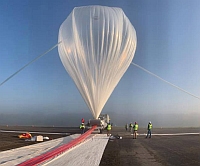
The picture that ilustrates this edition of TSR was taken in April 9, 2019 at the launch pad of the Columbia Scientific Balloon Facility in Palestine, Texas during a Crew Chief Training balloon release. This kind of operations serve to train staff of the facility on launch procedures using repaired or unfit for flight balloons. The balloon is released from the spool but not set free. Image by Ross Hays.
-
HAPS Alliance unveiled
HAPS Alliance unveiled
Through a press release published on February 21, 2020, was presented to the world the HAPS Alliance, an association of world-leading telecommunications, technology, aviation, and aerospace companies that are united in promoting the use of high altitude vehicles in the Earth’s stratosphere. The acronym HAPS refers to High Altitude Platform Station and is a term that serve to encompass platforms like Unmanned Aerial Vehicles, Airships and balloons operating in such realm of the atmosphere.
Members of the new alliance include HAPSMobile, Loon LLC, AeroVironment, Airbus Defence and Space, Bharti Airtel, China Telecom, Deutsche Telekom, Ericsson, Intelsat, Nokia Corporation, SoftBank Corp. and Telefónica.

According to the presentation the alliance -originally an initiative from HAPSMobile and Loon- is created "...so member companies can collectively advocate for HAPS business development with the relevant authorities in various countries, build a cooperative HAPS ecosystem, develop common product specifications and promote the standardization of HAPS network interoperability. All of these activities will be key to the Alliance’s aim of addressing diverse social issues and creating new value by providing telecommunications network connectivity worldwide through the utilization of high altitude vehicles..."
With the increasing and menacing presence of space-based projects like Space-X's Starlink, the new alliance will became the first organized effort to create a lobby group in a field that could be subject to harsh competition in the near future between the concepts of "space-based" and "stratosphere-based" broadband connectivity.
Also, the endorsement of big telcos and aerospace players will help to overcome the reluctancy observed specialy in governments regarding the viability of such projects.
-
Project Loon news, plus launches, landings and current status of the balloon fleet
New study says that impact of Loon on a terrestrial LTE network is minimal
Signals Research Group (SRG) -a research and consulting services firm covering the wireless telecommunications industry- published early this month a benchmark study they performed on behalf of Loon LLC to know the impact that the balloon-based network have on land-based networks. The study entitled "Loon and a terrestrial LTE network" was ellaborated using data collected between September 23 and 27, 2019 in a region just south of Tarapoto, Peru combining drive testing and walk testing in a very rural part of the country. The main goal was to determine if Loon could be a "good neighbor" to the terrestrial network by providing adequate coverage in areas the terrestrial network did not cover and, most importantly, if could be minimized the interference at the boundary between the two networks. Additionally, RSG wanted to determine how well Loon performed and the subsequent user experience.
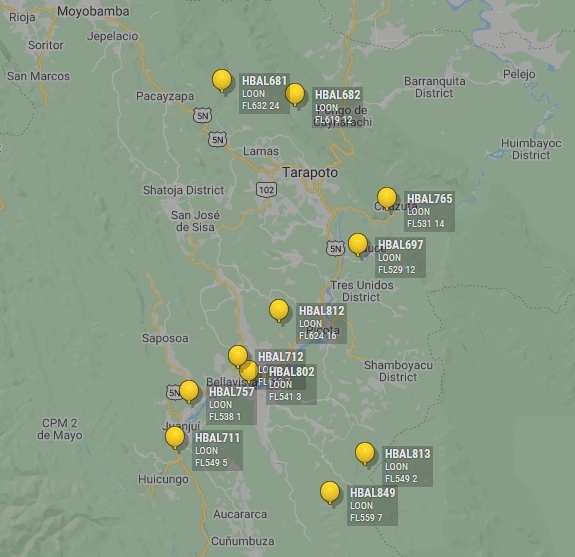
Balloons of the project Loon near Tarapoto, Peru during one of the days of the test.
The main conclusion is that Loon only has a modest detrimental impact on the existing terrestrial LTE network while improving coverage in areas where terrestrial LTE coverage does not exist . According to the report, self-interference between terrestrial LTE sites -which is typical in an LTE network- existed even in the absence of Loon. On the other hand, Loon's contribution to interference in the LTE network was comparable to the interference generated by other terrestrial cell site.
Same occur with the performance of the Loon network which is somewhat comparable to a terrestrial LTE network with similar attributes. As an example, the study affirms that when moving between Loon cells or between Loon and the terrestrial network (and vice versa) the smartphones used for the tests made a detach/attach to the network that was fast enough to pass unnoticed by testers.
Finally SRG points out that the user experience with Loon is surprisingly good. Separate from data speeds and latency, they evaluated how Loon performed with popular mobile data applications, such as web browsing, video chat, YouTube, and downloading applications from Google Play. According to the study, web page load times were very comparable with Wi-Fi and LTE, while the experience with streaming videos was favorable.
As wisely pointed by Fiercewireless on an article on the matter, as Loon needs to partner with a local carrier in any given location in order for it to work, this study could alleviate any concerns they might have.
The 63 pages document is available for download on SRG's website.
Loon's communications payload to be used in the Hawk30 stratospheric UAV
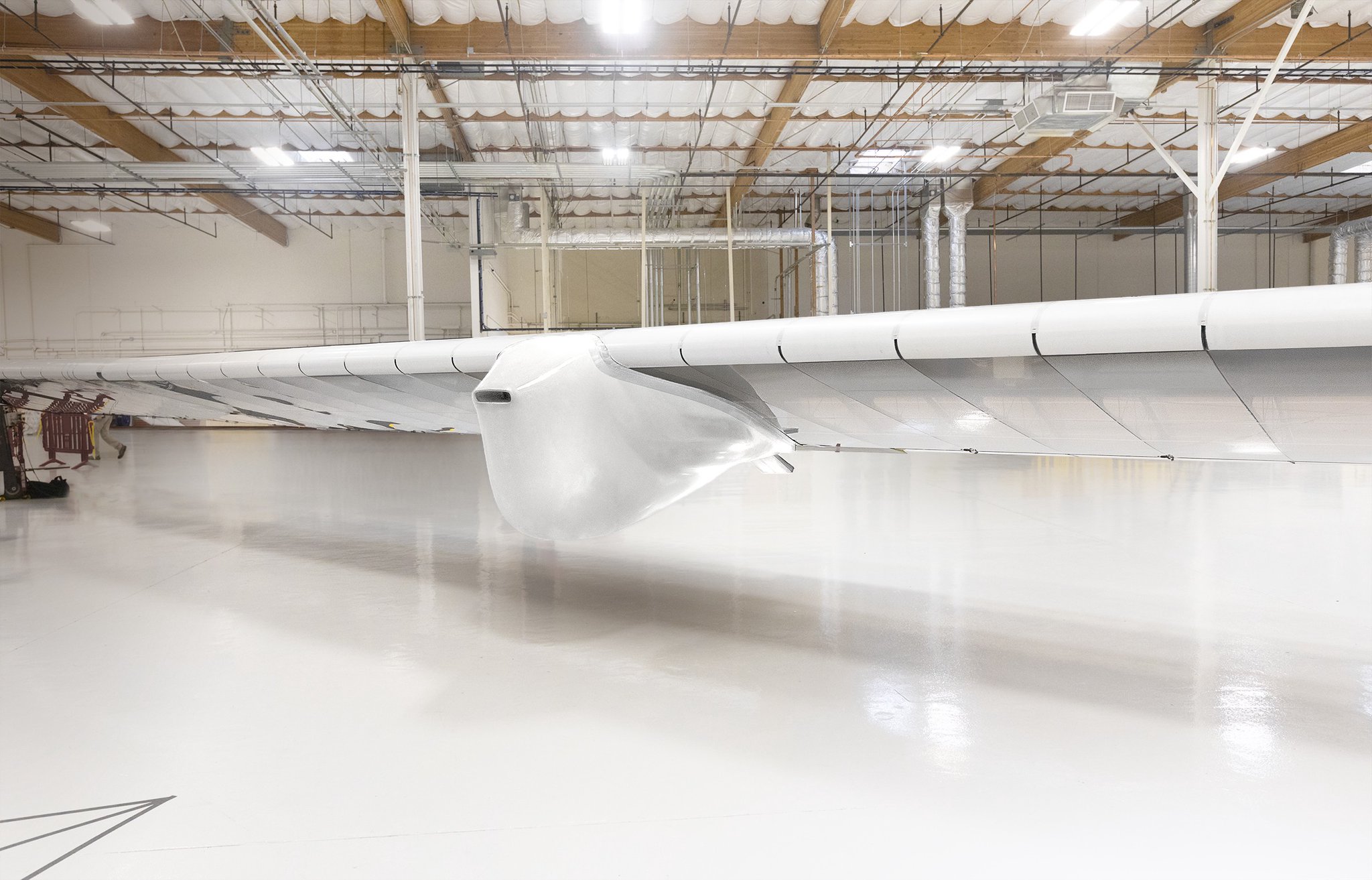
View of the payload pod of the Hawk30 UAV.
Loon is collaborating with HAPSMobile Inc. a division of SoftBank Corp. to adapt the communication payload developed in their balloons for use it onboard HAWK30, a stratospheric solar-powered unmanned aircraft system developed by the Japanese firm. The collaboration between the two companies started back in April 2019 when the signing of a strategic alliance was announced.
According to the press release published on Loon's blog in Medium, the effort leveraged on Loon's expertise in building communications payloads that are capable of enduring the harsh conditions of the stratosphere for long-periods of time. The communications payload jointly developed by Loon and HAPSMobile consists of a number of components that enable it to serve as a stratospheric cell tower. Millimeter wave communication systems provide the backhaul links that connect the vehicle to a physical internet access point on the ground, and allow multiple vehicles to connect with one another in the stratosphere.
Technicians installing Loon's communication payload on Hawk30 UAV.
The payload houses highly accurate antennas that are capable of establishing point-to-point connections at distances of up to 700 kilometers and carrying data at speeds up to 1 Gbps. In order to keep a stable connection, the antenna is designed to rotate as flight vehicles move.
On the Loon system, this technology has proven the ability to reliably maintain a stable connection to the ground and nearby flight vehicles. In recent tests, Loon established and maintained a connection among 20 balloons spanning over 4,000 kilometers.
However, as the HAWK30 is designed to fly faster than the balloons, the Loon technical team had to adapt the communication system to accommodate significantly higher flight speeds. Software improvements allow the antenna to rotate more quickly and track more rapid movements.
The press release states that the newly developed communications payload utilizes a custom-designed LTE system that operates on various 3GPP-compliant frequency bands, thus allowing HAWK30 to provide a wireless link of LTE connectivity directly to standard LTE smartphones and other mobile devices.
Loon could be soon testing broadband service to maritime vessels in Puerto Rico
As published by Monica Alleven in Fiercewireless on February 18, Loon submitted filings before the Federal Communication Commission (FCC) of the United States seeking permission to conduct some testings in the 71-76 GHz and 81-86 GHz bands. Although the details remains confidential, the purpose of the request is to perform a market trial to deliver broadband service to maritime vessels using part of their fleet of balloons as relay transmission points in Puerto Rico.
The company asked to the FCC that information related to its experimental license application be treated as confidential and not subject to public inspection based on the fact that the disclosure of certain information would cause significant economic and competitive harm.
"Loon seeks authority to transmit in the 71-76 GHz and 81-86 GHz (“E-band”) from fixed base stations in Puerto Rico that will utilize High Altitude Platform Stations (“HAPS”) as relay transmission points to deliver broadband service to maritime vessels operating in line-of-sight."
In the documents attched to the request the company detailed some of the aspects of the testing:
"...(Loon) will maintain locational awareness and have the ability to terminate transmissions to and from HAPS balloons. First, the platforms will contain a GPS receiver. If the receiver detects that the platform has exited its desired operational range, it will automatically mute transmissions over the test frequencies. Second, connections to the ground infrastructure can be used to manually disable transmissions. Third, the airborne radios will automatically mute transmissions if the connection to the ground infrastructure is lost for a defined period of time..."
The interesting revelation by Fiercewireless could be the answer to the sustained presence around the Island of Puerto Rico of several balloons of the Loon fleet in last weeks. In a more deep level, the move may be interpreted as a search for diversification and the widening of potential business horizonts for the company. Is well know that inside Google's ecosphere nothing escapes to the eye scrutiny of Sundar Pichai who appears to be decided to cut off those projects not able to emerge as meaningful businesses.
Latest balloon launches performed by Project Loon

The launch activity of Project Loon during the period of time covered by this report has been centered in launching operative flights from Puerto Rico, with a few flights for testing from Winnemucca, Nevada. All balloons mentioned here remain in flight unless noted.
On January 23, was launched from Winnemucca, HBAL 117 about 17:17 utc and remained in flight 6 hours and 20 minutes before landing 30 km W of Battle Mountain, Nevada. There is a chance -taking account of the altitude to which it rose- that the balloon used in this mission was bigger than usual.
Two days later on January 25, three balloons were launched from Jose Aponte de la Torre airport in Puerto Rico. HBAL 116 at 18:49 utc, HBAL 129 at 20:57 utc and finally HBAL 092 at 22:44 utc.
Four days later on January 29, two balloons were launched also from the island: HBAL 115 at 21:14 utc and HBAL 130 at 22:21 utc. However, an apparent malfunction forced six days later to take down the first one, which landed on February 4 at 14:24 utc 80 km N of Uruará in the state of Pará, Brazil. That same night, another three balloons were sent aloft also from Puerto Rico: HBAL 111 at 00:01 utc, HBAL 125 at 1:16 utc and HBAL 109 at 3:03 utc. Of this second batch of launches, the first two still remains in flight, but the third one landed in the United States on February 22 at 4:15 utc after being aloft merely 23 days. Landing spot was located in the state of Texas 15 km SSE of Eldorado
Back to Nevada, on January 31 was launched at 18:04 utc HBAL 118. It remained in flight 5 hours and 45 minutes before landing 40 km NW of Eureka.
The first night of February, three more balloons were added to the fleet from Puerto Rico: HBAL 126 at 21:14 utc, HBAL 132 at 22:18 utc and finally HBAL 026 at 1:32 utc. Two nights later in rapid sucession were also sent aloft from the island the last three balloons to join the fleet: HBAL 131 at 21:47 utc, HBAL 136 at 22:43 utc and HBAL 137 at 23:35 utc.
Last launch for this edition occured on February 28 at 15:15 utc. The balloon with callsign HBAL 134 remained in flight a little more than six hours before landing in Nevada 11 km NNE of Tuscarora.
Latest landings performed by Project Loon
During the time frame covered by this report, 13 balloons were terminated: five in Brazil, four in Australia, one each in United States, Mexico and Peru and one balloon which apparently was lost in the North Atlantic.
The first two landings occured in Brazil on January 25. HBAL 075 a 72 days old balloon launched from Puerto Rico on November 14, landed at 11:31 utc in the state of Rio Grande do Sul, 17 km NNW of the town of Pinheiro Machado. The second one that landed that day was HBAL 073 also launched from Puerto Rico but in November 13, 2019. The balloon was terminated above the state of amazonas and landed at 23:57 utc 76 km ENE of Pauini. Total flight time was 73 days.
Last landing of January occured in Peru on the 29th. HBAL 024, originally launched on October 2, 2019 from Nevada finished its flight in the San Martin Department in a spot located 37 km NW of the city of Moyobamba. Total flight time was 119 days.
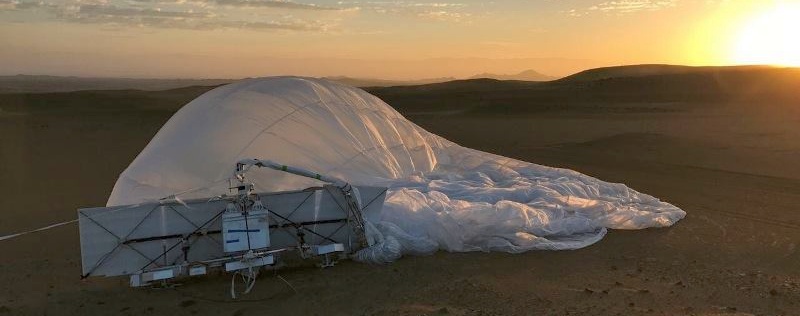
On the first day of February in Brazil was the turn to land of HBAL 789 launched on June 26, 2019 from Puerto Rico. The landing occured at 11:19 utc in the state of Piauí, 11 km E of Taperinha. This was one of the "elders" balloons of the fleet with 220 days in flight.
On February 4, another "oldie" of the fleet was landed in Australia after 217 days aloft: it was HBAL 677 launched from Puerto Rico on July 2, 2019. The landing occured at 5:35 utc in the desert, 23 km NNW of Nituriya.
Four days later also in Australia was terminated HBAL 011 which was in flight since launched from Nevada on September 6, 2019. The landing occured at 00:17 utc 16 km SW of Barkly Homestead Roadhouse in Northern Territory. Total flight time for this one was 153 days.
That same day but in Brazil was the turn to land of HBAL 070 launched in October 30, 2019 from Puerto Rico. The periple of 101 days ended at 12:06 utc 18 km N of Carauarí, in Amazonas State.
Back to Australia, two balloons were landed within two hours in the same area east of Kulgera, in the Northern Territory on February 9. The "twins" were HBAL 744 and HBAL 795 both launched from Puerto Rico the same day -June 27, 2019- which were taken down at 19:55 utc and 21:15 utc respectively. The remarkable flight time of both balloons was 227 days.
Six days later HBAL 090 a balloon launched from Puerto Rico on January 7, 2020 returned to the continental US and landed in Nevada at 13:30 utc 50 km NW of Winnemucca. Total flight time was 39 days.
On February 22 while was being moved apparently towards Texas for recovery HBAL 098 a balloon launched from Puerto Rico on December 4, 2019 landed in an isolated region of the Zacatecas State in Mexico. The landing spot was 20 km NE of the small town of Aldea de Codornices and the total flight time was 80 days.
On February 27 while was flying in the north Atlantic Ocean, HBAL 037 a balloon launched from Puerto Rico on October 18, 2019 vanished from my tracking system and never returned since. At the time of the disappearance -20:40 utc- it was flying at an altitude of 18 km apparently without problems. The last point on which was tracked was located at coordinates 23º 41' N - 49º 4' W. Total flight time until that moment was 132 days.
Last landing for this edition occured in Brazil on February 28. At 1:10 utc that day HBAL 041, a balloon launched from Puerto Rico on October 26, 2019 landed 4 km N of the small settlement of Iahá in the Amazonas State. Total flight time for this one was 125 days.
Current status of Project Loon's balloon fleet
As of March 5, 2020 at 19:00 utc the total number of balloons in flight is 36. Currently, the youngest balloon aloft is HBAL140 which has been merely 2 days in flight, while the oldest member as mentioned before is HBAL703 which is now floating lonely in the Central Pacific. So far it accumulated 292 days aloft.
The map below shows the aproximate location of the balloon fleet:
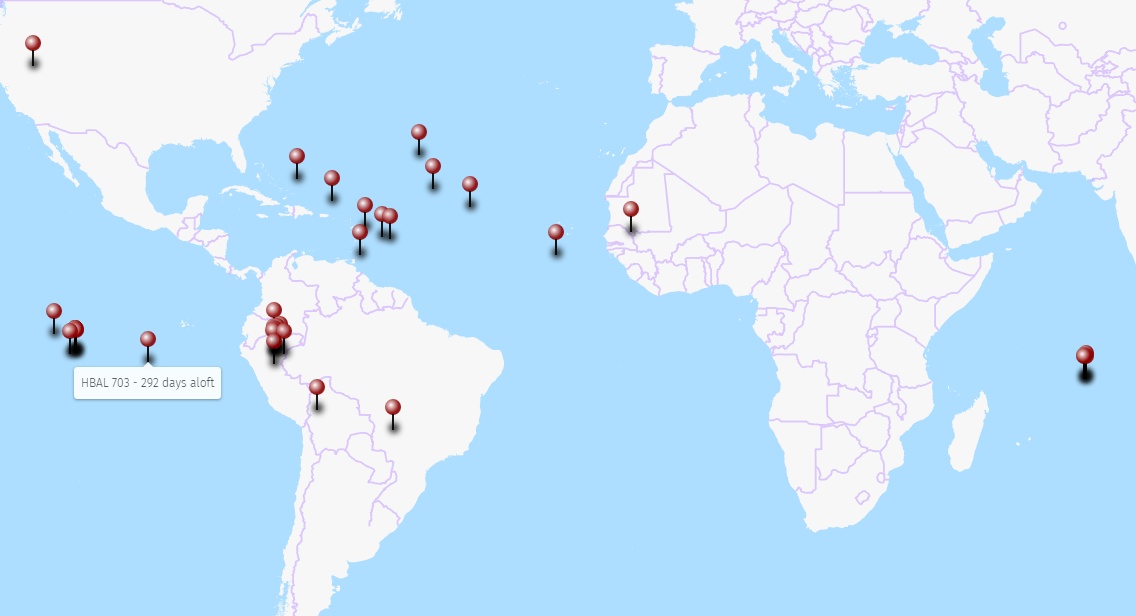
-
NASA campaign in Antarctica (IV)
Travalb still in flight
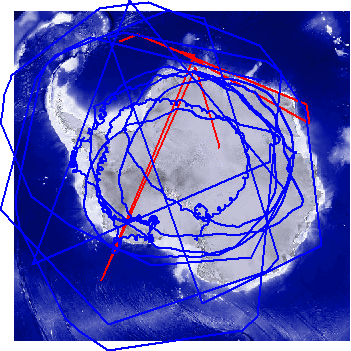
Real time location of the TRAVALB-2 Flight 707N from the onboard GPS system.
While all NASA staff left Antarctica weeks ago, TRAVALB the last balloon sent aloft during the balloon launch campaign is still circling around the continent on it's 67th day aloft. However, as we can see in the map at right, it's not making the perfect circles typical of early austral summer. Instead, the balloon is lost in an endless series of loops and turns which makes highly unpredictable were the wind will send it. In fact, that's the very reason of the experiment carried onboard: to test NASA's trajectory predictions in Antarctica and also see how long and where the balloon goes.
So far, the super-pressure balloon which was hand launched on December 29, 2019 as mission 707N shattered all endurance marks for these balloons launched by NASA in Antarctica.
As part of the payload, is also onboard a detector of the Balloon Array for RBSP Relativistic Electron Losses or BARREL, a program designed to study electron losses from Earth's Radiation Belts.
Back to the other participants of the antarctic campaign the Super-TIGER experiment which was launched on December 15 and was terminated 33 days later has been recovered from the Ice. But regarding the failure earlier in the flight of BLAST-TNG that I've covered in detail in last issue, there is a tight silence and nothing has been known about the incident itself or the efforts to recover the instrument.
Upcoming NASA launch campaign in New Zealand
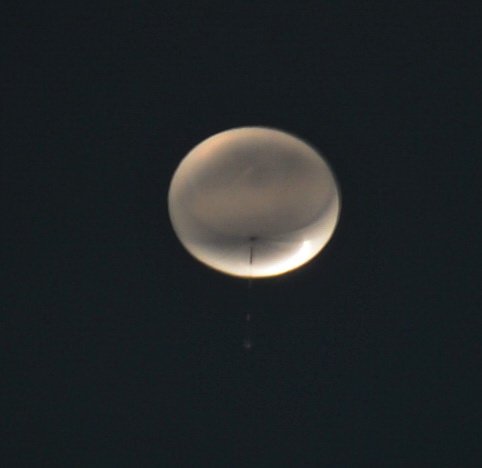
The NASA Superpressure balloon launched from Wanaka, New Zealand in 2017
Meanwhile, NASA is starting a new balloon launch campaign this time from Wanaka, New Zealand. If all goes according to the plans, weather permitting between March and April will be performed the fourth mission of the NASA superpressure balloon (SPB). NASA's SPB have a troubled history, including many failures and several redesigns. However, after some key problems were identified and resolved, the agency started in 2005 a step-by-step testing program, which would led in 2015 to the first succesful mission carried out from Wanaka using a 18.000.000 cubic feet balloon. That mission endured 32 days aloft, and was followed in 2016 by a second one also launched there that endured 46 days. This second flight of the SPB transported for the first time a scientific payload, a soft gamma-ray telescope denominated COSI (Compton Spectrometer and Imager) developed by the Space Sciences Laboratory, University of California, Berkeley.
This year, an improved version of COSI will be flown.
A third mission was launched in 2017 transporting the EUSO-SPB instrument, aimed to observe and measure Ultra High Energy Cosmic Ray Air Showers by looking down from near space with a fluorescence detector. The instrument was part of a larger project called JEM-EUSO. However, during the flight the SPB developed a leak and sunk in the Pacific Ocean before reaching the coast of South America.
The development of this fourth mission of the SPB will be of paramount importance for the future of the program.
Stay tuned !
-
World View launch/landing activity
Another Stratollite lost in the Atlantic Ocean
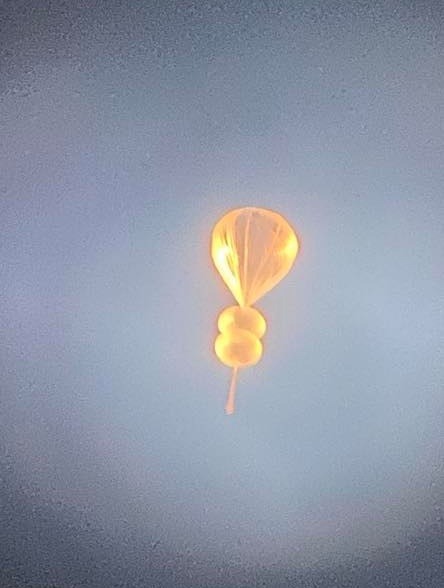
View of GRYPHON 17 balloon above Louisiana on February 16 being illuminated by the rays of the setting sun (Image: Facebook).
Following the fate of it's predecessor, the latest mission performed by a Stratollite of the Tucson-based company World View, ended also in failure. Althought details were not published by the company, the mission dubbed as GRYPHON-17 ended with the sunk of the vehicle and it's cargo in the Atlantic Ocean east of the Lesser Antilles. Until the moment of the sinking, the mission appeared to unfold without any trouble.
The balloon was launched on the morning of February 12, 2020 from Spaceport Tucson, the main launch facility of the firm. Once airborne and after a nominal ascent phase, the Stratollite achieved full presurization of the superpressure ballast balloon and achieved float altitude around 70.000 ft. The it followed the usual flight path across the southern part of Arizona, New Mexico also transiting briefly into Mexico. Entering in Texas, the craft performed some hovering manouvers over two different areas in the west and central part of the state before regaining the original eastbound route across the southern part of the United States. On Sunday 16 the balloon was clearly visible in the sky of Louisiana and generated some headlines in the media. Also some nice pictures -like the one seen at left- appeared on social media showing what at the moment appeared to be a quite healthy balloon.
A few hours later the balloon moved into the Atlantic Ocean and after some days of navigation and again some hovering periods it turned slowly to the south. Then, all the sudden on February 22, World View's official tracking page was deactivated -as occured with the previous mission- and after making a quick check on the ADS-B tracking network, I've realized that the balloon was losing altitude and finally dissapeared of the system about 6:00 utc in a point located east of Guadalupe Island in the Lesser Antilles.
Below these lines is a map of the flight path of the balloon. Total flight time of Gryphon-17 was 9 days 14 hours and 30 minutes.
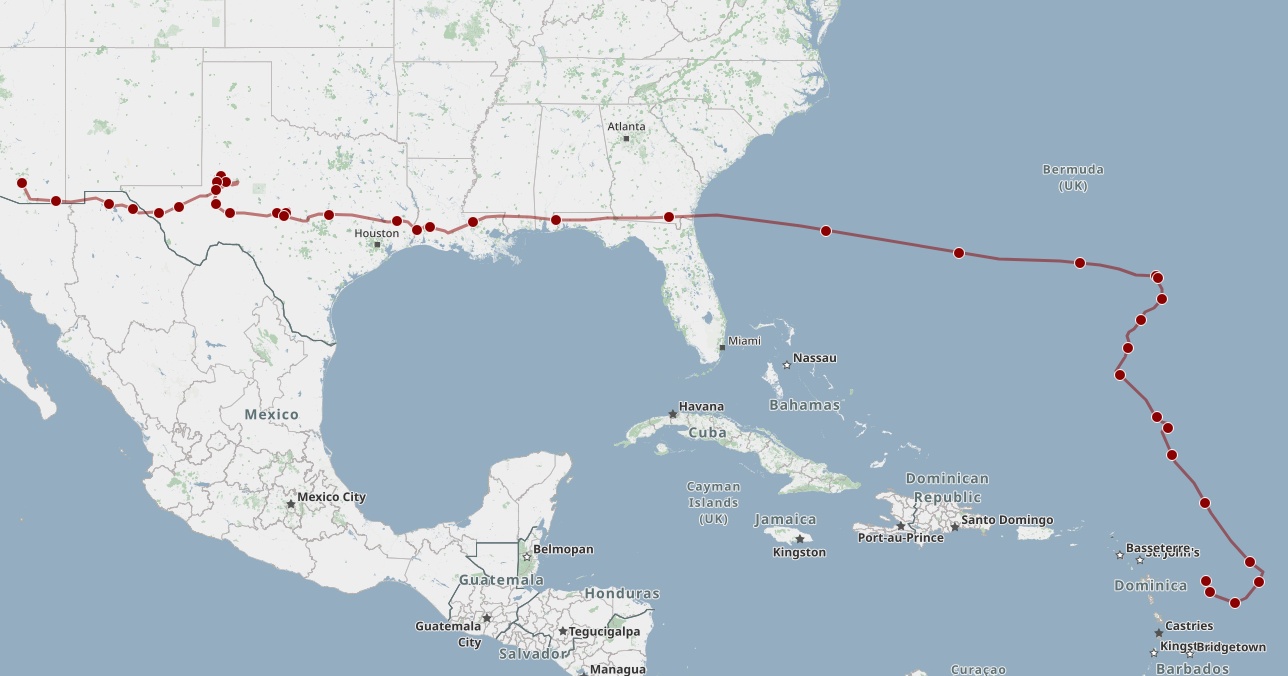
A couple of weeks passed since the incident and the company had not made any mention on social media or the institutional website about what happened with their craft.
Is the abrupt end of the flight an indication of a mission failure?. The answer is ambiguous. It all depends if the objectives of the mission were achieved. If the mission had a particular goal which was reached despite the vehicle loss, it can be considered even in this circumstances a success. However, if part of the objectives of the flight were to stay in flight some amount of time or make a longer navigation the answer is the opposite.
A third option for answering this, is a mix of both. Some objectives could be achieved but still the consecutive loss of two full systems in an advanced stage of the flight is an indication of a flight system still needing maturation.
-
Strateole 2 campaign in Seychelles (VI - Final)
Strateole 2 campaign completed

After more than three months of flight, the eight balloons launched during November and December as part of the Strateole 2 campaign carried out by CNES and several other institutions in Seychelles Islands, had landed/amerized.
The official end of the campaign occured at 10:05 utc on February 28, 2020 when the last balloon still in flight (dubbed as ST2_CO_03_TTL3) was terminated in the Pacific Ocean, 100 miles off-shore Ecuador. Althought the instruments onboard such long duration missions are considered as "expendable" its recovery would be welcome by the scientific team specially to assess its condition after such a harsh flight. Unfortunately, with the vast majority of the balloons descending in high seas and the only one that made a landfall, ending in a remote location of Mali, none of the payloads were recovered.
In the map below these lines can be seen the landing site of each of the balloons with their respective duration aloft.

The longest flight of the entire campaign endured 107 days 6 hours and 39 minutes in flight while the shortest one flew for 53 days 21 hours and 30 minutes. In all, the eight constant level balloons achieved a grand total of 674 days aloft corresponding to a mean duration of 84 days per balloon. As a curious note, one of the balloons perfomed a turn of the world in exactly 80 days, a sort of futuristic remake of the classic 18th century masterpiece created by the great Jules Verne.
Aside of the data obtained -which will be presented by Stephanie Venel from CNES this summer in the COSPAR meeting in Sidney, Australia- the campaign served to validate the new design introduced for the Zephyr gondola and the real time control system also developed for the project. Upcoming phases of Strateole 2 will include two full fledged launch campaigns with 20 balloons each to be held also from Seychelles in 2021-22 and 2024-25.
Futhermore details of the initiative can be found visiting the Strateole 2 website.
-
Raven Aerostar activity
Latest launches by Raven Aerostar
Since the last edition of this report, 17 balloons were launched by Raven Aerostar. The activity was centered as usual in the Innovation Campus of the firm near Baltic, South Dakota and also in several remote locations of New Mexico and California. The details below.
On January 22, a Thunderhead system was launched as HBAL0373 about 11:00 utc from an undisclosed location in Santa Fe County, New Mexico. After ascending to 60.000 ft apparently it burst at 12:07 utc. The landing spot was located near Puerta de Luna, New Mexico after a flight of 1 hour and 40 minutes.
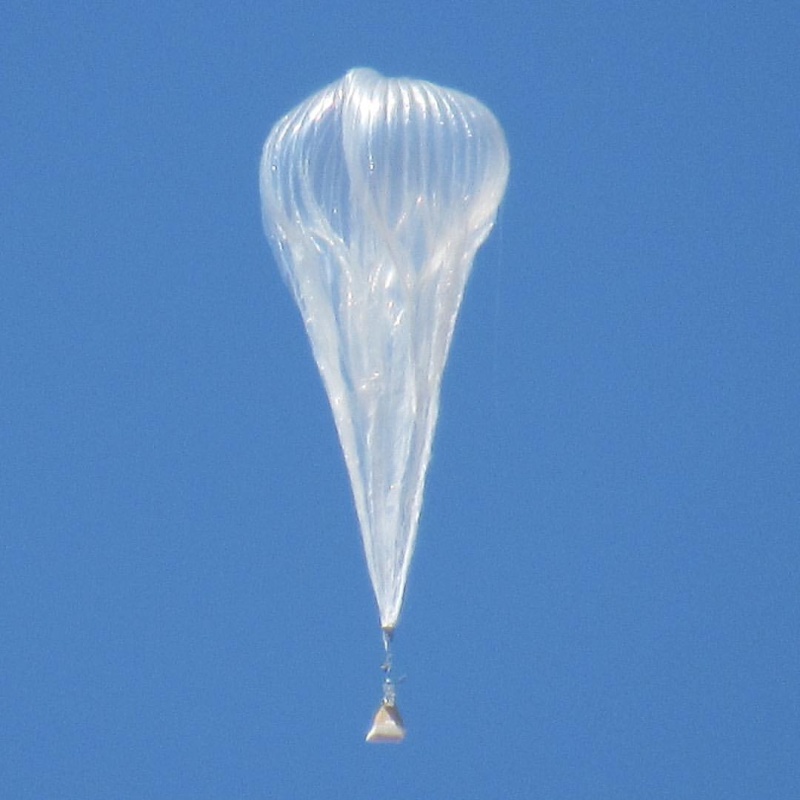
A Thunderhead balloon launched in 2019 from Artesia, New Mexico (Image: Marko Farion)
Then, on January 25, three balloons were launched all of them from Truth or Consequences, New Mexico. The first up was HBAL0374 which was launched at 10:00 utc. However, after reaching 61.000 ft, it apparently burst at 11:13 utc landing west of Tularosa. The next balloon launched was HBAL0375 at 10:48 utc. It reached also an altitude of 61.000 ft. After 4 hours and 15 minutes aloft it landed in the SE corner of White Sands National Park, New Mexico. Finally last launch of the day was HBAL0376 which was sent aloft at 13:30 utc. It flew for 8 hours and 40 minutes at 55.000 ft before landing at 22:10 utc, NE of Carlsbad, New Mexico.
Back to South Dakota, the last two balloons of January were launched from Baltic on January 29. HBAL0377 a Thunderhead system was released at 15:40 utc and remained in flight nine days before descending on February 7 at 14:30 utc in a point located 4 km SE of Seawillow, Texas. The second flight of the day was HBAL0378 which was launched at 17:00 utc and landed 5 hours later near Perkins, Iowa.
During the first half of February, the launch activity remained centered in Baltic. On Feb. 5 at 14:44 utc was launched HBAL0379. It ascended up to 51.000 ft and was last tracked five hours later SE of Titonka, Iowa. Five days later on Feb. 10 was the turn of HBAL0380 which was launched at 10:26 utc. After floating at about 60.000 ft a little more than six hours it descended near Lime Springs, Iowa.
On February 13 was launched at 16:40 utc HBAL0381. After spending 4 hours and 20 minutes at 65.000 ft it landed about 21:20 utc near Emmetsburg, Iowa.
Starting the second half of February, operations moved back to the southwest with two more launches performed from Santa Fe County in New Mexico. The first one was HBAL0382 which was launched at 15:00 on Feb. 15. It remained aloft for six hours and a half before landing at 21:30 utc that same day near Lake Summer in New Mexico.
The next launch occured on Feb. 20 at 3:00 utc. The balloon with callsign HBAL0383 moved to the southeast across New Mexico and Texas, crossed the Gulf of Mexico before turning to the west and crossing Mexican airspace. It was tracked for the last time on Feb. 28 moving further west above the Pacific Ocean 150 miles SE of the shore of the state of Colima in Mexico.
A short duration mission was performed back in Baltic (SD) on February 24. The balloon with callsign HBAL0384 was released at 14:56 utc and remained aloft until landing at 18:45 utc when landed NW of Ottawa, Iowa. Total flight time was three and a half hours.
Following that last launch in South Dakota, the rest of the activity occured from remote locations.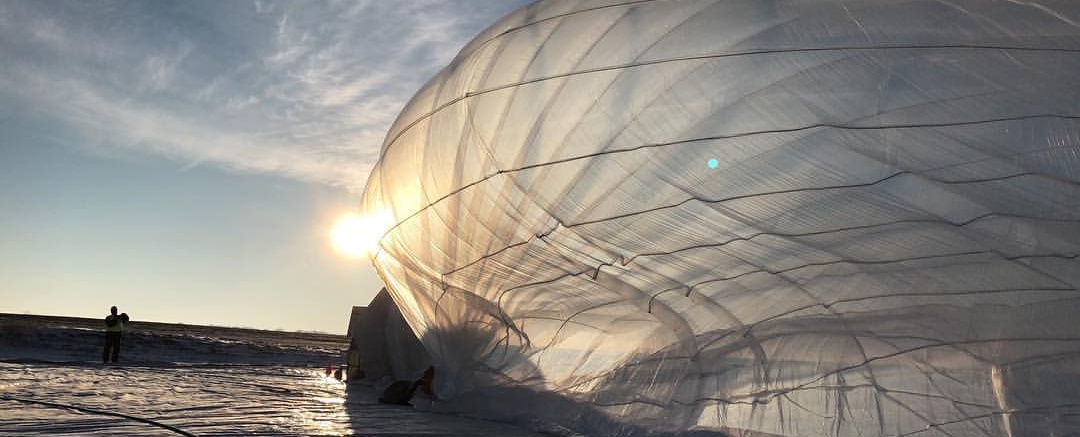
A Thunderhead balloon being prepared for launch (Image: Alex Hofer)
Between February 26 and 27, a Raven team was deployed to southern California to perform a series of balloon launches from diverse locations. First balloon up was HBAL0385 which was launched from the area of Twentynine Palms about 21:30 utc. The tracking data was not conclusive enough to identify exactly the launch location which could be the local airport or the Marines Corp base located further NW of the city. The flight moved eastbound and ended after 7 hours aloft about 4:30 utc. The landing spot was located inside the NE corner of Yuma Test Range, SE of La Paz Valley, Arizona.
On Feb. 27 two balloons were launched as part of the same operation. This time the launches were performed from the Desert Center Airport or probably the Chiriaco Summit Airport both in the same area of southern California. The first balloon launched was HBAL0386 which was released at 18:15 utc. It flew for nine hours before landing near Theba, Arizona the next day. The second balloon of the day HBAL0387 was launched about 20:15 utc following a similar path and landing in the same spot than its predecessor. Flight time also was about 9 hours.
Finally, to end this summary of the flight activity by Raven Aerostar, two more launches were performed from the undisclosed location in Santa Fe County, New Mexico on the last day of February. The first one HBAL0389 was released at 13:45 utc and was last tracked that same day NW of Santa Rosa. Then at 15:00 utc was launched HBAL0388 which after crossing the country eastbound went into the Atlantic Ocean. It was last tracked before closing this edition on March 4, in a point located 200 km SW of Bermuda Islands.
-
News in brief
Balloon-related news in brief
This is a resume of some interesting news about sientific ballooning published during the last month.
Testing of parachutes for Mars2020 delayed
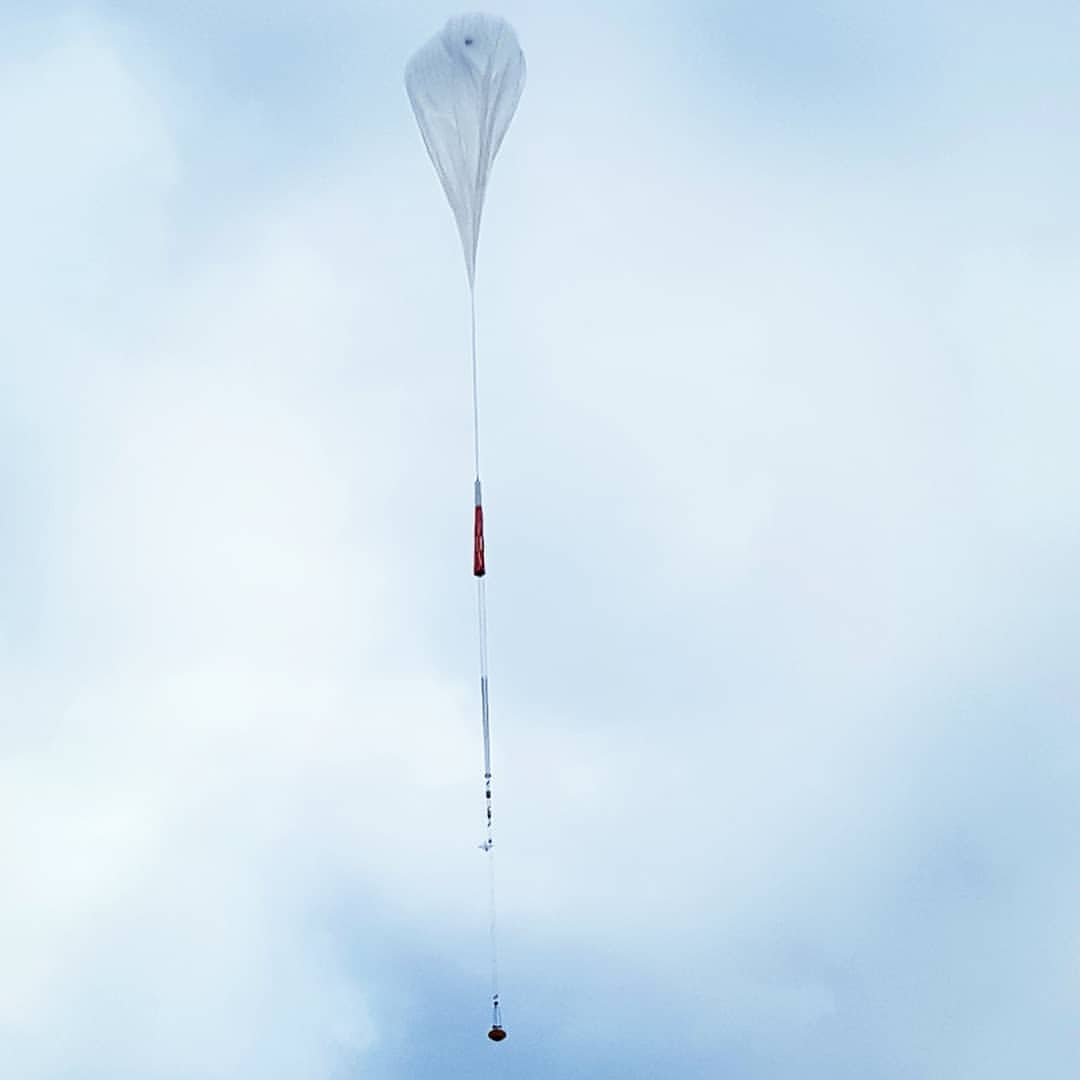
The European and Russian space agencies have delayed crucial ExoMars 2020 parachute tests to late March, with the mission also set to face review.
The high altitude drop tests of the two main parachutes are now planned for the end of March 2020, an ESA spokesperson told SpaceNews via email. The delay comes despite six ground tests demonstrating successful parachute extraction, the point at which damage was caused in earlier failed high altitude tests.
As planned, the balloon-based missions will be performed in Oregon.
Odd neutrino event registered by ANITA telescope

In a paper just published in ArXiv entitled A search for IceCube events in the direction of ANITA neutrino candidates an impressive huge collaboration of scientists are studying three odd events involving Neutrinos.
These high energy particles blasted up through the ice of Antarctica, setting off detectors in the Antarctic Impulsive Transient Antenna (ANITA) experiment, a balloon-borne instrument which was floating under a NASA balloon far above the frozen surface.
An extense article analizing these events and it's implicancies for the physics's "Standard Model" has been published by Rafi Letzter on Space.Com
Cheap balloon telescopes rival space observatories
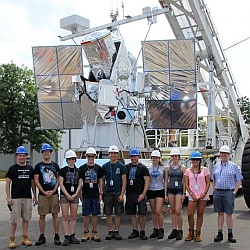
No instrument has revealed more about the heavens than NASA’s Hubble Space Telescope, which cost nearly $5 billion to build and launch. Yet a team of researchers thinks it can match some of Hubble’s capabilities with a telescope costing a mere $2 million, hoisted to the edge of space on a balloon. On a September 2019 flight, the Superpressure Balloon-borne Imaging Telescope (SuperBIT) demonstrated the ability to hold steady and image distant stars with exquisite resolution approaching Hubble's, the team is now reporting.
The interesting article by Adrian Cho, is available at the website of Science Magazine.


